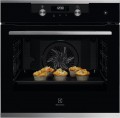Cooking temperature
The cooking temperature range allows you to understand which special tasks are subject to the oven. The lower temperature from which the oven starts heating, usually, is in the range of +30 to +50 ˚C. So, for example, the minimum heating temperature at
+30 ˚C allows you to defrost products. Models with a minimum of
40 ˚C and
50 ˚C allow you to heat ready meals, heat tableware (before serving), dry crackers, etc.
Number of modes
The number of cooking modes provided in the design of the oven. In this case, the cooking mode means the general opertaion mode — for example, “heating”, “heating + convection”, etc. Accordingly, this indicator strongly depends on additional equipment (see "Features"). However, even in similar models, the number of modes may be different. In general, the
more cooking modes, the more cooking options, the easier it will be to choose the optimal mode for a specific situation.
Door closer
The presence of an
automatic door closer in the design of the oven.
Such a device is responsible for pulling the door when closing, and in some models, when opening. The idea is that the user does not need to close/open the door completely — just pull it to the right place, and then the door will be smoothly brought to a fully open or closed state by the door closer. Such a system performs two functions. Firstly, it reduces to almost zero the risk of leaving the oven not completely closed (which is fraught with various unpleasant situations): the auto-closer is usually able to attract even a fairly wide open door. Secondly, such a device provides a very smooth opening and closing, without shock, which has a positive effect on the service life of the entire oven.
Oven cleaning
The type of inner cleaning provided in the oven. Note that pollution has to be removed with a rag or sponge, but modern ovens often provide various tricks that facilitate the process. The options might be:
—
Catalytic. A special wall coating is used in ovens with this cleaning method: it breaks down fats and other stubborn dirt into constituent elements that can be easily removed. The effectiveness of such a coating decreases over time, but it is enough for at least several years of full use. It should be noted that the catalytic coating can be implemented by applying it to special removable plates that are installed on the back or side walls of the oven chamber.
—
Steam cleaning. Cleaning with hot steam, which softens dried-on dirt and partially breaks down fats. In some models, there is a built-in steam generator for this, in others it is enough to put a container of water in the working chamber and turn on the cleaning program.
—
Pyrolytic. Cleaning by heating the chamber to a very high temperature — about 500 ° C. At this temperature, most of the contaminants are incinerated into ash, which can then be easily removed. Pyrolytic cleaning is considered the most effective, but ovens with this function are expensive, time consuming, require significant electricity/gas consumption, and can lead to unpleasant odors.
Energy class
This indicator characterizes how economically the oven consumes electricity. Initially, classes were marked in Latin letters from
A(highest) and further down as they went down. Later improved classes
A +,
A ++, etc. appeared (the more pluses, the better). More energy-efficient models are more expensive but can pay for themselves in the process of use, especially if you have to cook often and in large quantities.
Connected load
The electrical power consumed by the oven during operation, in other words, the power that must be supplied to the oven so that it can work normally. This parameter determines not only the total energy consumption (and, accordingly, the amount of electricity bills) but also the specifics of the power supply: with a power consumption of several kilowatts, a conventional outlet may not be suitable, and the wiring must be quite reliable.
Note that it is customary to indicate the connection power only for electric models (see "Oven"), as well as for gas devices with electric grills.
Country of origin
The country in which, according to the manufacturer, this or that model is manufactured. Even though most of the capacities are concentrated in
China, European factories for the production of household appliances have not disappeared. And certain models can be produced on them. In general, such a division into a Chinese or European factory (
Germany,
Italy,
Poland,
Turkey) should not particularly affect the quality of products, but still the stereotype of a reliable European assembly is present in us. However, it is possible that the model may have a country of manufacture, for example, Poland, and in the store under the same article, you will meet China.

